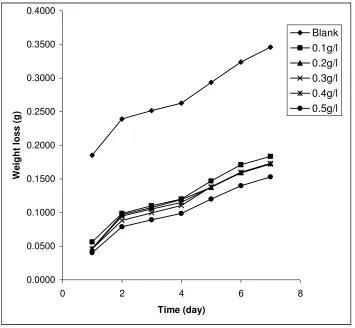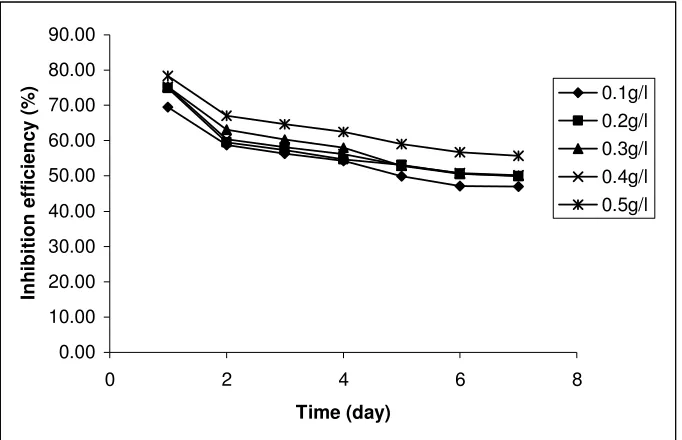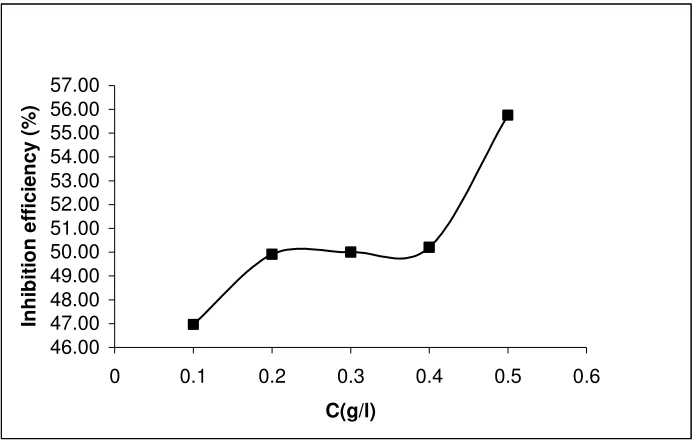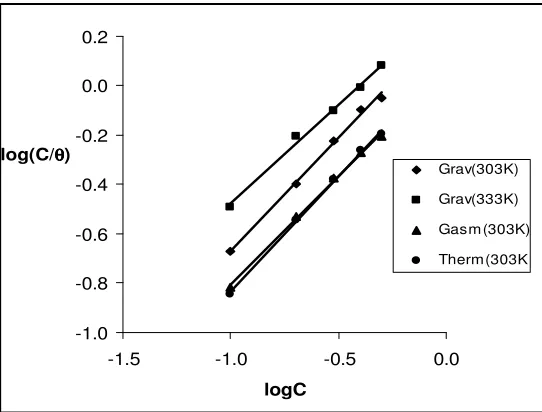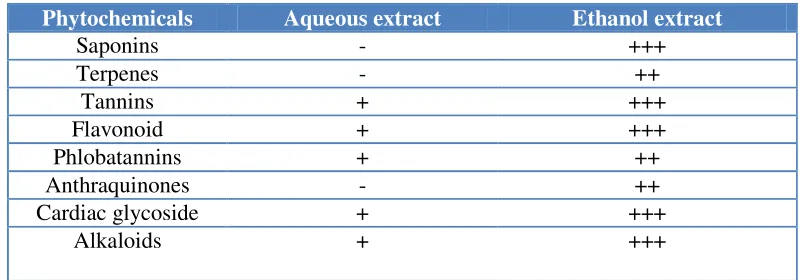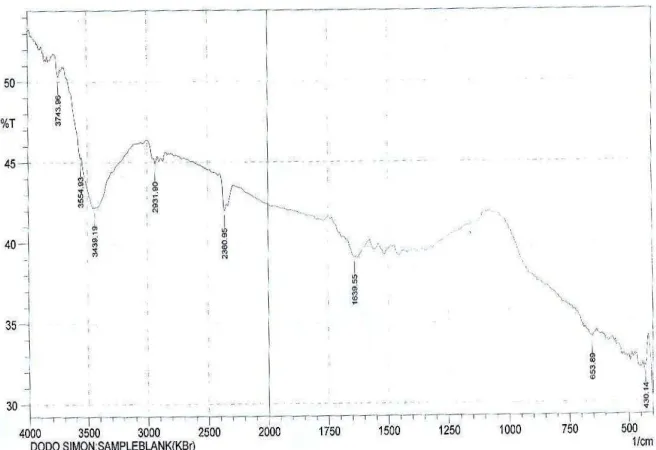Int. J. Electrochem. Sci., 5 (2010) 1996 - 2011
International Journal of
ELECTROCHEMICAL
SCIENCE
www.electrochemsci.org
Adsorption and Inhibitive Properties of Ethanol Extracts of
Leaves of
Solanum Melongena
for the Corrosion of Mild Steel in
0.1 M HCl
Nnabuk O. Eddy1, Femi Awe1 and Eno E. Ebenso2,*
1 Department of Chemistry, Ahmadu Bello University, Zaria, Nigeria 2
Department of Chemistry, North West University (Mafikeng Campus), Private Bag X2046, Mmabatho 2735, South Africa
*
E-mail: Eno.Ebenso@nwu.ac.za , nabukeddy@yahoo.com
Received: 30 October 2010 / Accepted: 5 November 2010 / Published: 1 December 2010
Inhibitive and adsorption properties of ethanol extracts of leaves of Solanum melongena (SM) were studied using gravimetric, gasometric, thermometric and FTIR methods. The results obtained indicated that the ethanol extract of leaves of SM is a good adsorption inhibitor for the corrosion of mild steel in HCl solution. The inhibition efficiency of ethanol extracts of leaves of SM was found to increase with increasing temperature. The adsorption of the ethanol extracts of leaves of SM on mild steel surface is exothermic, spontaneous and is best described by the Langmuir adsorption model. The values of activation and free energies obtained were within the range limits expected for the mechanism of physical adsorption. Quantum chemical calculations revealed that the active constituents of ethanol extracts of leaves of SM are carotene, nicotinic acid, ascorbic acid and riboflavin and that the order for their inhibition potentials is thiamine >β-carotene > riboflavin > ascorbic acid > nicotinic acid. Examination of the FTIR spectra of the corrosion products of mild steel and that of ethanol extracts of leaves of SM before and after adsorption indicated that the adsorption of the inhibitor is enhanced by the aromatic and C=C in β-carotene and –OH bonds in thiamine, riboflavin, ascorbic acid and nicotinic acid.
Keywords: Mild steel, corrosion, inhibition, adsorption, Solanum melongena
1. INTRODUCTION
metal is prone to corrosion. In order to reduce the menace due to corrosion of industrial installations, several steps have been adopted. However, one of the best options available for protecting metals against corrosion involves the use of corrosion inhibitors [4].
Most of the best known corrosion inhibitors are organic compounds which contain electronegative functional groups and π-electrons in triple or conjugated double bonds. For this class of inhibitors, the presence of heteroatoms (such as S, N, O and P) as well as aromatic rings in their structures is the major adsorption centre [5].
Several inhibitors have been synthesized and used for the inhibition of the corrosion of mild steel in acidic medium but some of these inhibitors are not environmentally friendly [6]. Green corrosion inhibitors are cheap, biodegradable and do not contain heavy metals or other toxic substances [7]. The successful uses of naturally occurring substances to inhibit the corrosion of metals in acidic and alkaline environment have been reported by some research groups [8-12]. On this note, ethanol or aqueous extracts of some plants have been found to be good corrosion inhibitors for some metals (notably aluminium, mild steel and zinc). However, literature is scanty on the use of ethanol extracts of leaves of Solanum melongena as inhibitor for the corrosion of mild steel in HCl solution. Therefore, the present study is aimed at investigating the inhibitive and adsorption properties of ethanol extracts of leaves of Solanum melongena (SM) for the corrosion of mild steel in solutions of HCl. Solanum melongena belongs to the family, Solanaceae (also known as the nightshades) and genus Solanum. The leaves of this plant have been found to have medicinal uses [13-14].
2. EXPERIMENTAL TECHNIQUES
2.1. Materials
Materials used for the study were mild steel sheet of composition (wt %); Mn (0.6), P (0.36), C(0.15) and Si (0.03) and Fe (98.86). The sheet was mechanically pressed cut into different coupons, each of dimension, 5 x 4 x 0.11 cm. Each coupon was degreased by washing with ethanol, cleaned with acetone and allowed to dry in the air before preservation in a desiccator. All reagents used for the study were analar grade and double distilled water was used for their preparation. Concentrations of HCl prepared for gasometric, thermometric and weight loss studies were 2.5, 2.5 and 0.1 M respectively.
2.2. Extraction of plants
2.3. Gravimetric method
In the gravimetric experiment, a previously weighed mild steel coupon was completely immersed in 250 ml of the test solution in an open beaker. The beaker was covered with aluminium foil and maintained at 303 K. After every 24 hours, the corrosion product was removed by washing each coupon (withdrawn from the test solution) in distilled water, containing 50 % NaOH and 100 g l-1 of zinc dust. The washed coupon was rinsed in acetone and dried in the air before re-weighing. The experiment was repeated at 333 K. In each case, the difference in weight for a period of 168 hours was taken as the total weight loss. From the average weight loss (mean of three replicate analysis) results, the inhibition efficiency (%I) of the inhibitor, the degree of surface coverage (θ) and the corrosion rate of mild steel (CR) were calculated using equations 1, 2 and 3 respectively [15];
%I = (1 – W1/W2) x 100 (1)
θ = 1 - W1/W2 (2)
CR= ∆W/At (3)
where W1 and W2 are the weight losses (g) for mild steel in the presence and absence of the inhibitor, θ is the degree of surface coverage of the inhibitor, A is the area of the mild steel coupon (in cm2), t is the period of immersion (in hours) and ∆W ( ∆W = W2 – W1) is the weight loss of mild steel after time, t.
2.4. Gasometric method
Gasometric methods were carried out at 303 K using a gasometer, equipped with facilities for measuring the volume of hydrogen gas liberated per minute. From the volume of hydrogen gas evolved per minute, inhibition efficiencies were calculated using equation 4 below [16].
%I = 1 100
1
x V V
o Ht Ht
− (4)
where VHt1 and VHto are the volumes of H2 gas evolved at time,‘t’ for inhibited and uninhibited solutions respectively.
2.5. Thermometric method
temperature per minute was recorded until constant values were obtained. From the rise in temperature of the system per minute, the reaction number and the inhibition efficiency were calculated using equations 5 and 6 [17]:
(
)
RN C T T
t
o m i
min−1 = −
(5)
%I RN RN
RN
aq wi
aq
= −
(6)
where RN is the reaction number in °C min-1, Tm and Ti are the maximum and initial temperatures attained by the systems respectively and‘t’ is the time (in minutes) taken to attain the maximum temperature, RNaq is the reaction number in the absence of inhibitors (blank solution) and RNwi is the reaction number of 2.5 M HCl containing the studied inhibitor.
2.6. Chemical analysis
Phytochemical analysis of ethanol extract of leaves of SM was carried out according to the method reported by Odiongenyi et al. [18].
Frothing and Na2CO3 tests were used for the identification of saponin. Bromine water and ferric chloride tests were used for the identification of tannin. Leberman’s and Salkowski’s tests were used for the identification of cardiac glycosides while Dragendorf, Hagger and Meyer reagents were used for the identification of alkaloid.
2.7. Infra red analysis
FTIR analyses were conducted on the corrosion product of mild steel and on the ethanol extract of leaves of SM by mixing the sample with KBr powder.
2.8. Quantum chemical calculations
Single point energy calculations were carried out using PM6 Hamiltonian in the MOPAC 2008 software for Windows. Calculations were performed on an IBM compatible Intel Pentium IV (2.8 GHz, 4 GB RAM) computer.
The following quantum chemical indices were calculated: the energy of the highest occupied molecular orbital (EHOMO), the energy of the lowest unoccupied molecular orbital (ELUMO) and the energy gap (ELUMO – EHOMO).
3. RESULTS AND DISCUSSIONS
3.1. Effect of ethanol extract of Solanum melongena (SM)
Fig. 1 shows the variation of weight loss with time for the corrosion of mild steel in 0.1 M HCl containing various concentrations of ethanol extract of SM at 303 K.
0.0000 0.0500 0.1000 0.1500 0.2000 0.2500 0.3000 0.3500 0.4000
0 2 4 6 8
Time (day)
W
e
ig
h
t
lo
s
s
(
g
)
[image:5.612.130.485.177.505.2]Blank 0.1g/l 0.2g/l 0.3g/l 0.4g/l 0.5g/l
Figure 1. Variation of weight loss with time for the corrosion of mild steel in 0.1 M HCl containing various concentrations of ethanol extracts of leaves of Solanum melongena at 303 K
It is evident from Fig. 1 that the weight loss of mild steel increases with increase in the period of contact but decreases with increase in the concentration of ethanol extract of leaves of SM. Therefore, extract retarded the corrosion of mild steel in HCl solutions.
[image:6.612.106.507.194.321.2]
Table 1 also reveals that the inhibition efficiencies obtained from gasometric and thermometric methods are relatively higher than those obtained from gravimetric method. This implies that the instantaneous inhibition efficiency of ethanol extract of leaves of SM is better than its average (obtained from gravimetric method) inhibition efficiency.
Table 1. Corrosion rate (CR) of mild steel and inhibition efficiencies (% I) of ethanol extracts of leaves of Solanum melongena for the corrosion of mild steel in 0.1 M HCl.
C (gl-1) CR
(303 K) CR (333 K) %I Grav. (303 K) % I Grav. (333 K) %I Gasm (303 K) %I (Therm) (303 K)
Blank 10.30 32.40 -
0.1 5.46 22.31 46.97 31.14 65.45 69.89
0.2 5.16 22.01 49.91 32.07 67.89 70.01
0.3 5.15 20.08 50.01 38.02 71.23 72.03
0.4 5.13 19.23 50.20 40.65 74.34 73.02
0.4 4.56 19.00 55.75 41.36 80.23 78.34
Key: CR = corrosion rate in gh-1cm2) x 10-5, Grav = results obtained from gravimetric analysis; Gasm = results obtained from gasometric analysis and Therm = results obtained from thermometric analysis.
0.00 10.00 20.00 30.00 40.00 50.00 60.00 70.00 80.00 90.00
0 2 4 6 8
[image:6.612.137.478.383.603.2]Time (day) In h ib it io n e ff ic ie n c y ( % ) 0.1g/l 0.2g/l 0.3g/l 0.4g/l 0.5g/l
Figure 2. Variation of inhibition efficiencies of ethanol extract of leaves of Solanum melongena with time.
seen that the extracts of the leaves of SM can retain more than 60 % of its inhibitive properties, after 168 hours of immersion.
3.2. Kinetic considerations
The kinetic study on the inhibition of the corrosion of mild steel in solutions of HCl by ethanol extract of leaves of SM was found to be consistent with a pseudo-first order reaction which can be expressed as follows [20],
-log(weight loss) = -k1t/2.303 (7)
where k1 is the first order rate constant and t is the time. Using equation 7, the plots of – log(weight loss) versus t were linear and are presented in Fig. 3.
0.0 0.2 0.4 0.6 0.8 1.0 1.2 1.4 1.6
0 2 4 6 8
Time (day)
-l
o
g
(w
e
ig
h
t
lo
s
s
) Blank
0.1g/l 0.2g/l 0.3g/l 0.4g/l 0.5g/l
Figure 3. Variation of –log(weight loss) versus time for the corrosion of mild steel in 0.1 M HCl containing various concentrations of ethanol extracts of leaves of Solanum melongena.
It is also significant to state that the half life (t1/2) of a first order reaction is related to k1 according to the following equation 8;
t 1/2 = 0.693/k1 (8)
[image:7.612.150.465.306.511.2]
Table 2. Kinetic and thermodynamics parameters for the adsorption of ethanol extract of leaves of Solanum melongena for the corrosion of mild steel
3.3. Effect of temperature
The effect of temperature on the corrosion of mild steel in HCl solutions (in the presence and absence of ethanol extract of leaves of SM) was investigated using the logarithmic form of the Arrhenius equation, which can be expressed as follows;
− = 2 1 1
2 1 1
303 . 2 log T T R E CR CR a (9)
where CR1 and CR2 are the corrosion rates of mild steel at the temperatures T1 (303 K) and T2 (333 K) respectively. Ea is the activation energy for the reaction and R is the molar gas constant (= 8.314 J/Kmol). The activation energies calculated from equation 9 were found to range from 59.42 to 60.24 kJ/mol. The values are higher than the value of 48.37 kJ/mol obtained for the blank indicating that ethanol extract of leaves of SM retarded the corrosion of mild steel in solutions of HCl. The activation energies were also found to be lower than the threshold value of 80 kJ/mol required for the mechanism of chemical adsorption. Therefore the adsorption of ethanol extract of leaves of SM on mild steel surface obeys the mechanism of physical adsorption [21].
3.4. Adsorption/thermodynamics considerations
The heat of adsorption of ethanol extract of leaves of SM on mild steel surface was calculated using the following equation [22],
1 1 2 2 1 1 1 2 2 1 log 1 log 303 .
2 −
− − − − = kJmol T T T T x R Q X ads θ θ θ θ (10)
where θ1 and θ2 are the degrees of surface coverage of the inhibitor at the temperatures, T1 (303 K) and T2 (333 K) respectively and R is the molar gas constant. Calculated values of Qads are presented
Kinetic parameters Thermodynamic parameters C (gl-1)
Slope K1 t1/2 (day)
Ea (kJ/mol)
Qads (kJ/mol) ∆∆∆∆Gads (kJ/mol)
Blank 0.676 1.56 0.45 48.37 - -
0.1 0.853 0.20 3.53 59.42 -14.10 -4.01
0.2 0.847 0.20 3.55 61.23 -15.67 -6.06
0.3 0.818 0.19 3.68 57.44 -10.26 -7.09
0.4 0.804 0.19 3.74 55.78 -8.11 -7.83
[image:8.612.103.509.105.234.2]
in Table 2. These values are negative and ranged from -8.11 to -15.67 kJ/mol indicating that the adsorption of ethanol extract of leaves of SM on mild steel surface is exothermic.
The free energies for the adsorption of ethanol extract of leaves of SM were calculated using equation 11 [23],
∆G0ads = -2.303RT log (55.5 Kads) 11
where R is the molar gas constant, T is the temperature in Kelvin, 55.5 is the molar concentration of water and Kads = θ/(1-θ)*[C].
46.00 47.00 48.00 49.00 50.00 51.00 52.00 53.00 54.00 55.00 56.00 57.00
0 0.1 0.2 0.3 0.4 0.5 0.6
C(g/l)
In
h
ib
it
io
n
e
ff
ici
en
cy
(%
[image:9.612.133.481.238.458.2])
Figure 4. Variation of inhibition efficiencies of ethanol extracts of leaves of Solanum melongena with concentration for the corrosion of mild steel in 0.1 M HCl at 303 K.
Calculated values of ∆G0ads are also presented in Table 2. Calculated values of ∆G0ads ranged from -4.01 to -8.96 kJ/mol and tend to be more negative with increasing concentration of the inhibitor. These indicate that the adsorption of ethanol extract of leaves of SM on mild steel surface is spontaneous and that the strength of the adsorption increases with increase in the concentration of the inhibitor. It is also significant to note that values of ∆G0ads, more negative than –40 kJ/mol are consistent with the transfer of electron from the inhibitor to the metal surface which represent a chemical adsorption whereas, values of ∆G0ads less negative than -40 kJ/mol signifies the mechanism of physical adsorption. Therefore the adsorption of ethanol extract of leaves of SM on mild steel surface supports the mechanism of physical adsorption from the values of ∆G0ads obtained from this study.
is characterized with initial increase in the surface coverage with increasing extract concentration until a certain concentration is reached, after which, the increase in the surface coverage with extract concentration becomes limited. This trend also indicates that at a higher level of extract concentration, the metal surface reaches saturation conditions with the adsorbed species.
-1.0 -0.8 -0.6 -0.4 -0.2 0.0 0.2
-1.5 -1.0 -0.5 0.0
logC
Grav(303K) Grav(333K) Gasm (303K) Therm(303K )
[image:10.612.170.441.157.363.2]log(C/θθθθ)
Figure 5. Langmuir isotherm for the adsorption of ethanol extracts of leaves of Solanum melongena on mild steel surface.
The adsorption characteristics of ethanol extract of leaves of SM on mild steel surface was also studied by fitting data obtained for the degrees of surface coverage into different adsorption isotherms including Frumkin, Temkin, Flory-Huggins, El Awardy et al, Bockris-Swinkel, Langmuir, Freundlich and Dublin-Radushkevich adsorption isotherms. The tests revealed that the data best fitted the Langmuir adsorption isotherm, which can be written as follows,
θ = KadsC x 1/(1+KadsC) (12)
where θ is the degree of surface coverage of the inhibitor, C is the concentration of the inhibitor in the bulk electrolyte and Kads is the adsorption equilibrium constant, which is also related to the free energy of adsorption of the inhibitor on the metal surface (see equation 11). Transformation of equation 12 yields equation 13;
log(C/θ) = logC - logKads (13)
[image:11.612.110.513.180.266.2]
from the Langmuir adsorption isotherm plots are presented in Table 3. The results obtained, indicate that the slopes and R2 values are very close to unity indicating that Langmuir adsorption isotherm is valid for this system.
Table 3. Langmuir adsorption parameters for the adsorption of ethanol extracts of leaves of Solanum melongena on mild steel surface
Method (temperature) Slope log Kads ∆∆∆∆G0
(kJ/ mol)
R2
Gravimetric (303 K) 0.9176 0.2487 -6.61 0.9968
Gravimetric (333 K) 0.8021 0.3234 -8.00 0.9928
Gasometric ( 303 K) 0.8826 0.0762 -3.633 0.9976
Thermometric (303 K) 0.9400 0.1040 -4.42 0.9980
Also using values of Kads, average values of ∆G0ads were also calculated and are also presented in Table 3. These values compare favourably with those obtained from equation 11 presented in Table 2.
3.5. Phytochemical constituents of ethanol extract of Solanum melongena
[image:11.612.105.507.488.628.2]Table 4 shows the phytochemical constituents of aqueous and ethanol extract of leaves of SM. It can be seen that ethanol extract of leaves of SM is richer in saponin, terpenes, tannins, flavonoid, phlobatanins, anthraquinones, cardiac glycoside and alkaloid.
Table 4. Phytochemical constituents of aqueous and ethanol extracts of leaves of Solanum melongena
Phytochemicals Aqueous extract Ethanol extract
Saponins - +++
Terpenes - ++
Tannins + +++
Flavonoid + +++
Phlobatannins + ++
Anthraquinones - ++
Cardiac glycoside + +++
Alkaloids + +++
Note: +++ = highly present, ++ = moderately present, - = absent or presence in negligible quantity
According to Schippers [24], the composition of Solanum melongena leaves (per 100 g) include, water 82.1 g, energy 215 kJ (51 kcal), protein 4.8 g, fat 0.3 g, carbohydrate 10.3 g, fibre 2.4 g, Ca 523 mg, P 94 mg, Fe 6.0 mg, β-carotene 6.40 mg, thiamine 0.23 mg, riboflavin 0.44 mg, niacin 1.8 mg and ascorbic acid 67 mg.
Figure 6. Chemical structures of some constituents of ethanol extracts of leaves of Solanum melongena.
[image:12.612.108.481.138.572.2]
atoms (Fig. 6). Therefore, the inhibition potentials of ethanol extract of leaves of SM is due to the synergistic effect of thiamine, riboflavin, niacin, ascorbic acid and β-carotene.
Table 5. Quantum chemical parameters for some phytochemical constituents of ethanol extract of leaves of Solanum melongena
Constituents EHOMO (eV) ELUMO (eV) ∆∆∆∆E
Thiamine -5.638 -1.225 4.413
β-carotene -6.566 -1.021 5.545
Riboflavin -9.333 -1.935 7.398
Ascorbic acid -9.867 -1.156 8.711
Nicotinic acid -10.358 -1.261 9.097
At this juncture, quantum chemical principles can be used to establish the order of importance of the implicated phytochemicals in corrosion inhibition. This is feasible because corrosion inhibition process involves the transfer of electron/charge from the inhibitor to Fe in mild steel. Also, the inhibition potentials of several compounds have been successfully correlated with their molecular and electronic properties including the frontier molecular energies, the Mulliken and Lowdin charges, the dipole moment, the cosmo area, cosmo volume, ionization potential, electron affinity, global hardness, global softness and electronegativity. Of significant interest in this study are the frontier molecular orbital energies (i.e., the energy of the highest occupied molecular orbital, the energy of the lowest unoccupied molecular orbital and the energy gap). Table 5 shows the frontier molecular orbital energies for the major phytochemicals in ethanol extract of leaves of SM.
[image:13.612.102.511.163.250.2]
3.6. FTIR study
[image:14.612.141.469.164.389.2]Fig. 7 shows the FTIR spectrum of the corrosion product of mild steel. From the spectrum, it is evident that the corrosion product of mild steel does not show any useful adsorption peaks because it is not IR active.
[image:14.612.142.475.448.687.2]Figure 7. FTIR spectrum of the corrosion product of mild steel.
Figure 9. FTIR spectrum of the corrosion product of mild steel in the presence of ethanol extracts of leaves of Solanum melongena.
Fig. 8 shows the FTIR spectrum of ethanol extract of leaves of SM while Fig. 9 shows the FTIR spectrum of the corrosion product of mild steel when the extract was used as an inhibitor. The frequencies and peaks of IR adsorption deduced from the spectra are recorded in Table 5. From the results obtained, C-H bend at 704.04 cm-1 is shifted to 655.82 cm-1, the C-H stretch at 896.95 cm-1 is shifted to 858.35 cm-1, the C-H bend at 947.08 cm-1 is shifted to 1006.88 cm-1, the C-N stretch at 1192.05 cm-1 is shifted to 1209.41 cm-1, the C-C stretch at 1421.58 cm-1 is shifted to 1410.01 cm-1 and the O-H stretch at 2928.04 cm-1 is shifted to 2937.68 cm-1. These shifts imply that there is interaction between the inhibitor’s molecules and Fe in mild steel [28]. However, some functional groups including the C-Cl stretch at 739.79 cm-1, the C-C stretch at 1624. 12 cm-1, the O-H stretch at 2685.00, 2985.91 and 3053.42 cm-1 were missing in the spectrum of the corrosion product indicating that these bonds might have been involved in bonding [29]. Comparing the FTIR results with the findings derived from quantum chemical parameters, it can be stated that the mechanism for inhibition of mild steel by ethanol extract of leaves of SM involves synergistic adsorption through the aromatic ring and double bond in carotene and –OH functional groups in nicotinic acid, ascorbic acids and riboflavin.
4. CONCLUSIONS
exothermic, spontaneous and supports the mechanism of physical adsorption. The experimental data obtained fits well into the Langmuir adsorption isotherm model.
References
1. L.R. Chauhan, G. Gunasekaran. Corros. Sci. 49(2007)1143.
2. E.E. Ebenso, H. Alemu, S.A. Umoren, I.B.Obot, Int. J. Electrochem. Sci. 3(2008) 1325.
3. S.A. Umoren, I.B. Obot, E.E. Ebenso, N. O. Obi-Egbedi, Int. J. Electrochem. Sci. 3(2008) 1029. 4. A.Y. El-Etre, Corros. Sci. 45 (2003) 2485.
5. H. Wang, X. Wang, H. Wang, L. Wang, A. Liu. J. Mol. Mod. 13 (2007) 147. 6. P.C. Okafor, V.I. Osabor, E.E. Ebenso, Pigment & Resin Technol., 36/5(2007) 299. 7. E.E. Oguzie, G.N. Onuoha, E.N. Ejike, Pigment & Resin Technol. 36/1(2007) 44. 8. P.C. Okafor, E.E. Ebenso, U.J. Ekpe, Int. J. Electrochem. Sci. 5 (2010) 978.
9. I.B. Obot, N.O. Obi-Egbedi, S.A. Umoren, E. E. Ebenso, Int. J. Electrochem. Sci. 5 (2010) 994. 10. N.O. Eddy, S.A. Odoemelam, Pigment & Resin Technol. 38(2009) 111.
11. N.O. Eddy, E.E. Ebenso, African J. of Pure & Applied Chem.12/6(2008) 1.
12. O.K. Abiola, N.C. Oforka, E.E. Ebenso, N.M. Nwinuka, Anti-Corrosion Methods & Materials 54/4(2007) 219.
13. D.R.A.Mans, J.Toelsie, S. Mohan, S. Jurgens, M. Muhringen, S. Illes, R. Macnack, R. Bipat. J of Ethnopharmacology 95/2-3 (2004) 329.
14. S. Mutalik, K. Paridhavi, N. Mallikarjuna Rao Udupa, Indian Jour. of Pharmacology 35(2003) 312.
15. S.A. Umoren, I.B. Obot, E.E. Ebenso, P.C. Okafor, O. Ogbobe, E.E. Oguzie, Anti-Corrosion Methods & Material 53/5 (2006) 277.
16. M.Kliskic, J.Radoservic, S. Gudic, V.Katalinic, J. Appl. Electrochem.30 (2000) 823. 17. S.A. Umoren, E.E. Ebenso, Pigment & Resin Technol.37/3 (2008) 173.
18. A.O.Odiongenyi, S.A. Odoemelam, N.O.Eddy, Portugaliae Electrochimica Acta 27(2009) 33. 19. M.G. Sethuran, P.B. Raja, Pigment & Resin Technol 34/6(2005) 327.
20. N.O.Eddy, P.A. Ekwumengbo, P.A.P. Mamza, Green Chem. Letters & Review 2/4(2009) 223. 21. H. Rehan, Materialwissenschaft & Werksofftechnik 34/2(2003) 232.
22. T.Y. Soror, J. Mat. Sci. & Technol. 20/4 (2004) 463. 23. E.A. Noor, J. Appl. Electrochem. 39(2009) 1465.
24. R.R. Schippers (2000) African indigenous vegetables. An overview of the cultivated species. Natural Resources Institute/ACP-EU Technical Centre for Agricultural and Rural Cooperation, Chatham, United Kingdom. 214 pp
25. N.O.Eddy, E.E.Ebenso, U.J. Ibok. J. Appl. Electrochem. 40(2) (2010) 445.
26. N.O.Eddy, U.J. Ibok, E.E. Ebenso, A. El Nemr, H. El Ashry, J. Mol. Model. 15(2009)1085. 27. T. Arslan, F. Kandemirli, E.E. Ebenso, I. Love, H. Alemu, Corros. Sci 51 (2009) 35.
28. N.O.Eddy, S.A. Odoemelam, A.O.Odiongenyi. J. Appl. Electrochem. 39(2009) 849.
29. N.O.Eddy, S.A. Odoemelam, A.O.Odiongenyi, Green Chem. Letters & Reviews 2(2009)111.
